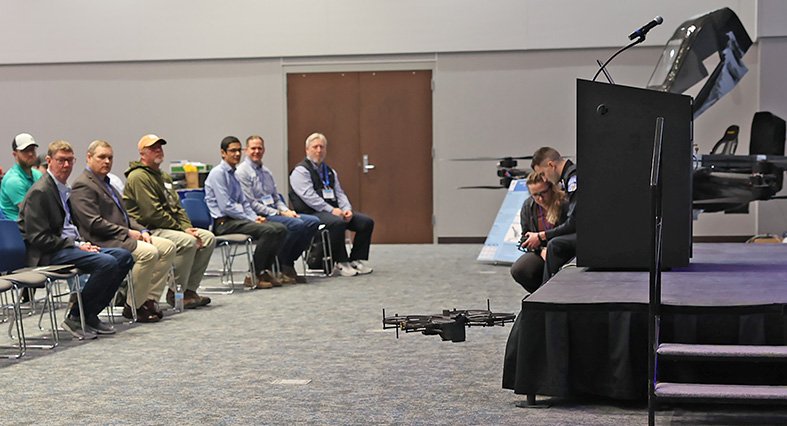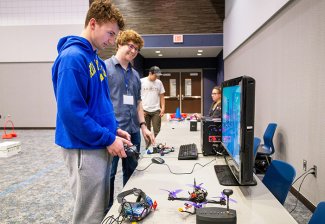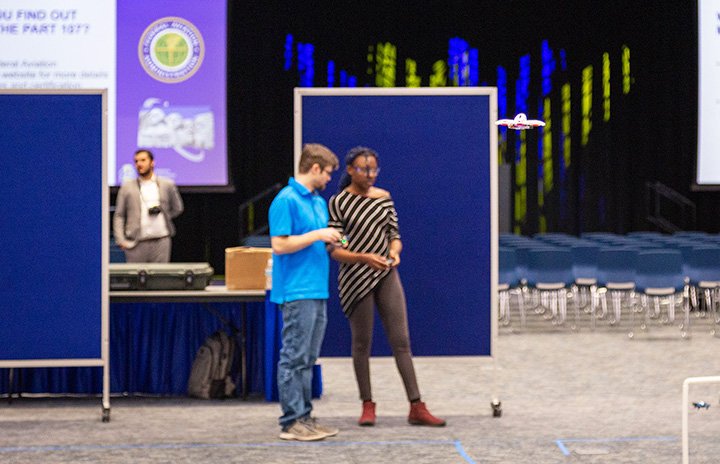

South Dakota State University hosted Drone Day on April 27, kicking off what organizers hope will be the first of many events that teach attendees how drones can be used in their jobs, free time and more.
The first-ever Drone Day was open to SDSU faculty, staff and students only, but organizers say they want to open future events up to the public after their trial run was a resounding success.
Attendees spent the first half of the day hearing from academics and experts who use drones on a regular basis in their fields: geography, law enforcement, precision agriculture, the South Dakota Department of Transportation, human transportation and more.
The second half of the day allowed anyone from beginners to experts to get in on flight lessons and drone racing, or just take the various machines on hand for a test drive.
Growing interest at SDSU, beyond
As interest in drones grows with the general public, it does at SDSU, too.
Since 2017, the Department of Geography and Geospatial Sciences has offered an uncrewed aircraft systems (UAS) certificate, which requires 12 credits and appeals to people outside the university who come back to campus to gain skills. An uncrewed aircraft systems minor, which requires 18 credits and is designed for students, will be added in the fall.
Both provide the knowledge and skills necessary to apply the technology to many fields of study or work, and both provide the knowledge necessary to attain the FAA Part 107 small UAS license needed to fly drones in a commercial capacity.
Over the past five semesters, more than 100 people have taken the department’s course Introduction to Small Uncrewed Aircraft Systems, said Bob Watrel, head of the Department of Geography and Geospatial Sciences. Another course, UAS Photography and Videography, was offered for the first time this spring and is already popular.
Richard Stephens, instructor for the Department of Geography and Geospatial Sciences, teaches three drone courses at SDSU and was instrumental in helping get the event off the ground, since he’s done so in other locations. His interest in drones is part of a larger interest in advanced air mobility, which he called the future of aviation. He expects to see Drone Day grow in years to come.
“For me personally, I’m going to be teaching a course, UAS Applications for Emergency Management, this fall, so having the Brookings Police Department and the Brookings County Sheriff’s Office here was really phenomenal,” Stephens said.
“I think the novelty of drones is going to become an emerging technology for the university,” he added, noting that the UAS classes he teaches are usually full. He said there are over 500 documented commercial applications for drones, everything from agriculture to zoology to meteorology.
Donovan Wilson, a graduate student studying geography with a GIS specialization, is president of SDSU’s Drone Club, which helped put on the event. He said it was important to have both the informational sessions in the morning and the engagement in the afternoon, when attendees were flying drones both in the Volstorff Ballroom and outside on the Jackrabbit Green.
The Drone Club is open to any SDSU student, and they don’t need their own drone to join. Besides flying drones, some student members build them as well.
Raising awareness
Julie Leidholt, instructor in the Department of Geography and Geospatial Sciences, said more people are using drones than some realize. Offering hands-on experience in a controlled environment can help people overcome their hesitation, misunderstandings and lack of knowledge in using drones.
“By having these speakers and providing these types of hands-on experiences, we can help bring awareness to the different opportunities and fields that are actively using drones,” she said.
Pilots take a knowledge test to obtain their Part 107 license to fly drones in a commercial capacity. To fly recreationally, pilots need a TRUST certificate, by passing an aeronautical knowledge and safety test online, and must provide proof of passage if asked by law enforcement or FAA personnel.
To fly drones on campus, pilots need university approval through the Division of Research and Economic Development, with policies based on South Dakota Board of Regents and FAA rules.
“Having all these courses, and having days like this where people can come in and get their feet wet or just show off the skills that they already have, is so important for the public,” Leidholt said. “In the last year, there are so many policy changes that have come out that it’s almost mind-boggling.”
And as drone popularity increases, more changes are coming down the line.
Leidholt said there’s not a regularly held drone conference in South Dakota, “so this offers at least some place for drone professionals, drone enthusiasts to come in the future to get this hands-on experience and to know the latest developments for drone usage, things of that nature.”

- Contact:
- Telephone number: 605-688-5544
Republishing
You may republish SDSU News Center articles for free, online or in print. Questions? Contact us at sdsu.news@sdstate.edu or 605-688-6161.

